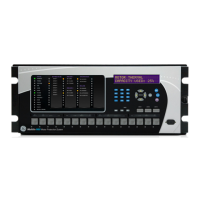5-112 M60 MOTOR PROTECTION SYSTEM – INSTRUCTION MANUAL
PRODUCT SETUP CHAPTER 5: SETTINGS
5
In networks containing one or more switches and/or clocks that do not implement both of these mechanisms, not all
delays are compensated, so the time of message arrival at the relay is later than the time indicated in the message. This
setting can be used to approximately compensate for this delay. However, as the relay is not aware of network switching
that dynamically changes the amount of uncompensated delay, there is no setting that always and completely corrects
for uncompensated delay. A setting can be chosen that reduces the worst-case error to half of the range between
minimum and maximum uncompensated delay, if these values are known.
PORT 1 ... 3 PATH DELAY ASSYMMETRY — This setting corresponds to “delayAsymmetry” in PTP, which is used by the peer delay
mechanism to compensate for any difference in the propagation delay between the two directions of a link. Except in
unusual cases, the two fibers are of essentially identical length and composition, so make this setting zero.
In unusual cases where the length of the link is different in different directions, set this setting to the number of
nanoseconds the Ethernet propagation delay to the relay is longer than the mean of path propagation delays to and from
the relay. For instance, if it is known say from the physical length of the fibers and the propagation speed in the fibers that
the delay from the relay to the Ethernet switch it is connected to is 9000ns and that the delay from the switch to the relay
is 11000ns, then the mean delay is 10000ns, and the path delay asymmetry is 11000 - 10000 = +1000ns.
5.3.7.3 SNTP protocol
SETTINGS PRODUCT SETUP REAL TIME CLOCK SNTP PROTOCOL
The M60 supports the Simple Network Time Protocol specified in RFC-2030. With SNTP, the M60 can obtain clock time over
an Ethernet network. The M60 acts as an SNTP client to receive time values from an SNTP/NTP server, usually a dedicated
product using a GPS receiver. UR family relays support unicast, broadcast, multicast, and anycast SNTP functionality.
The
SNTP FUNCTION setting enables or disables the SNTP feature on the M60.
To use SNTP in unicast mode, set
SNTP SERVER IP ADDR to the SNTP/NTP server IP address. Once this address is set and SNTP
FUNCTION
is “Enabled,” the M60 attempts to obtain time values from the SNTP/NTP server. Since many time values are
obtained and averaged, it generally takes three to four minutes until the M60 clock is closely synchronized with the SNTP/
NTP server. It takes up to two minutes for the M60 to signal an SNTP self-test error if the server is offline.
To use SNTP in broadcast mode, set the
SNTP SERVER IP ADDR setting to “0.0.0.0” and SNTP FUNCTION to “Enabled.” The M60
then listens to SNTP messages sent to the “all ones” broadcast address for the subnet. The M60 waits up to 18 minutes
(>1024 seconds) without receiving an SNTP broadcast message before signaling an SNTP self-test error.
The
SNTP UDP PORT NUMBER is 123 for normal SNTP operation. The change takes effect when the M60 is restarted.
5.3.7.4 Local time
SETTINGS PRODUCT SETUP REAL TIME CLOCK LOCAL TIME
SNTP PROTOCOL
SNTP FUNCTION:
Disabled
Range: Enabled, Disabled
SNTP SERVER IP ADDR:
0.0.0.0
Range: standard IP address format
SNTP UDP PORT
NUMBER: 123
Range: 1 to 65535 in steps of 1
Do not set more than one protocol to the same TCP/UDP port number, as this results in unreliable operation of
those protocols.
LOCAL TIME
LOCAL TIME OFFSET
FROM UTC: 0.0 hr
Range: –24.0 to 24.0 hr in steps of 0.5
DAYLIGHT SAVINGS
TIME: Disabled
Range: Disabled, Enabled
DST START MONTH:
January
Range: January to December (all months)

